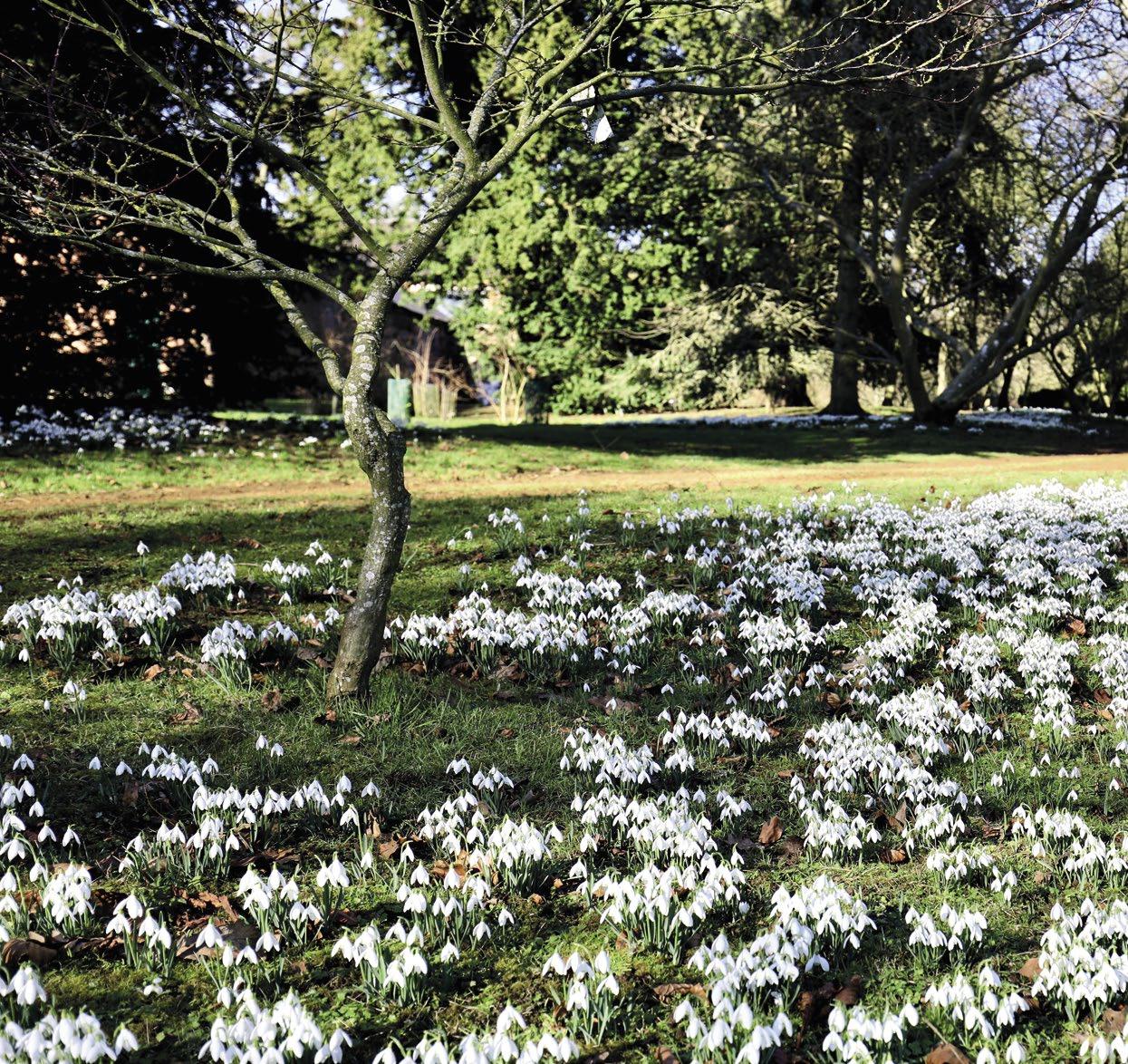
5 minute read
LOCAL HISTORY
Snowdrops in Northamptonshire
The shy stars of spring
If ever there was a sight to warm the heart on a cold day, it is a carpet of snowdrops on a woodland floor. With their delicate heads poking through the hard ground and nodding in the winter winds, they send an optimistic message that spring is on the way, and that all is well. This month is the perfect time to wrap up warm and enjoy their blooms in one of our beautiful Northamptonshire historic gardens. Because these tiny but vigorous plants appear throughout the British Isles wherever conditions are favourable, it is easily assumed that they are a native species, or possibly introduced by the Romans two millennia ago. However, the snowdrop was introduced perhaps a mere 500 years ago. The earliest English reference to them appears in John Gerard’s Great Herbal in 1597, where he refers to them as ‘timely flouring bulbus Violet’.
Laura Malpas looks closer at the history of the humble Snowdrop with suggestions where to see them locally.

By his 1633 edition, they have gained the common name ‘snowdrop’. Gerard states that the plants originated in Italy and were often to be found in the gardens of collectors, especially in London. They were fashionable, and as such appeared in the gardens of the wealthy landed gentry, especially those who favoured the consciously ‘natural’ gardens styles made fashionable in the eighteenth century. Many of our Northamptonshire country houses introduced these bulbs into their woodlands and gardens, more of this later! Perhaps because snowdrops appear at a time of year when there are few other flowers showing, they exert a special fascination and even affection in the eye of the beholder. They have been given many charming names, such as ‘February fairmaids’ or ‘Candlemas bells’, and those who collect and admire the bulbs have their own name ‘Galanthophile’. This originates from the snowdrop’s Latin classification Galanthus. During the Victorian period the snowdrop became even more popular. The simplicity and purity of its appearance struck a sentimental chord with artists, poets, and plantsmen alike. New varieties were sought after and exchanged hands for serious money.
Left: Thenford Arboretum Below: Coton Manor Garden Bottom left: Galanthus Atkinsii Bottom right: Rockingham Castle
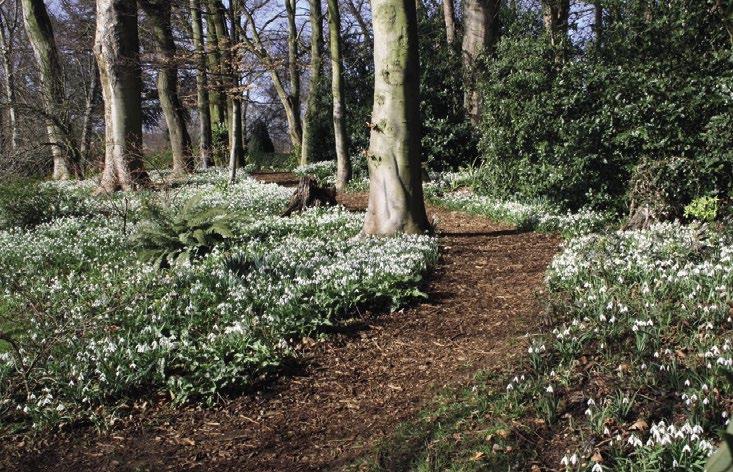
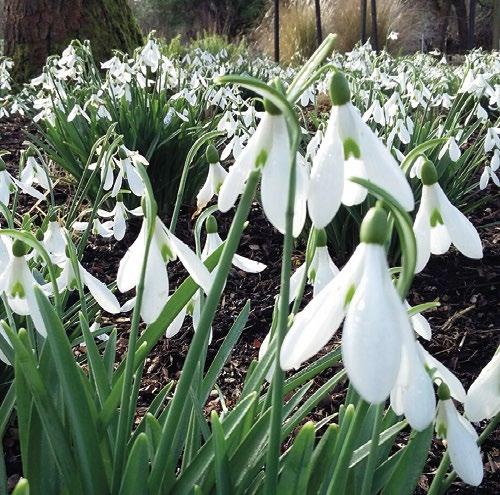
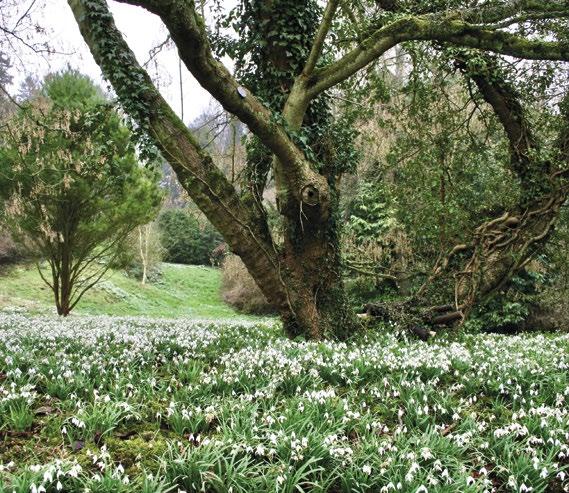
One of the most popular varieties was discovered and named by a Northamptonshire plantsman, James Atkins (1806 – 1884). Atkins was a nurseryman on the Kingsthorpe Road in Northampton, specialising in growing pelargoniums and tropical orchids in his glasshouse. He eventually retired to a cottage in Painswick, Gloucestershire, and took a holiday travelling in the Alps. He returned with a snowdrop bulb he had purchased nearby to Naples thinking it was Galanthus Imperati. But it was something different and he cultivated it for sale, releasing it some five years later. It is an early bloomer, with long slender outer petals, each inner petal has a small green heart shaped mark at its tip, and a distinctive honey fragrance. It was renamed Galanthus Atkinsii and proved very popular. It remains well regarded and highly desirable today. Nowadays, galanthophiles can easily become obsessed with all things snowdrop. In Northamptonshire there is quite a competition to collect the greatest number of different varieties. Many country house gardeners tell me they grow in excess of three hundred varieties, and Thenford Arboretum have claimed over six hundred! Many of these are kept very carefully as their bulbs can be worth several hundreds of pounds.
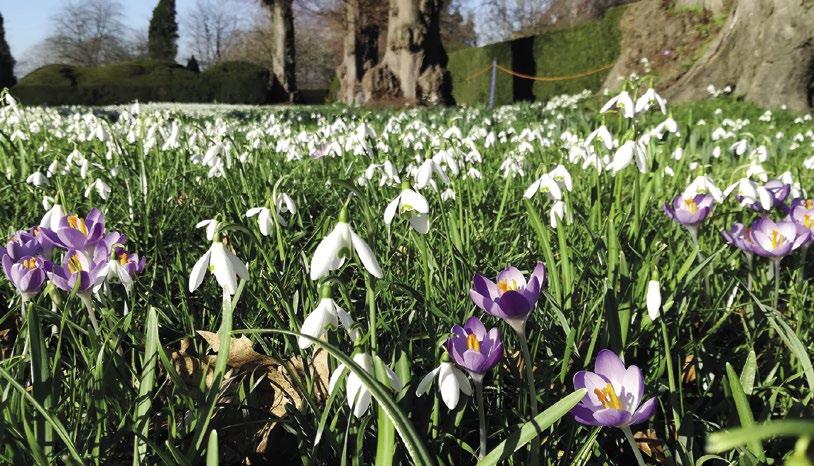
Thenford Arboretum Lamport Hall
A single bulb of Galanthus ‘green tear’ sold for £360 a few years ago, and recently, the world record price for a single snowdrop bulb was smashed when a golden yellow and white Galanthus woronowii sold at auction for £725.
Luckily, we have an abundance of places in Northamptonshire where we can enjoy these beautiful harbingers of spring. Here are just a few of my favourite places, although there are many more. Please note that you must check the relevant websites to ensure that the gardens are open before you set off, and opening times and dates will vary. Some also require pre-booking. And as snowdrops can’t read a calendar they may decide to bloom earlier or later than expected. However, the last two Sundays in February offer the best chance for a snowdrop visit.
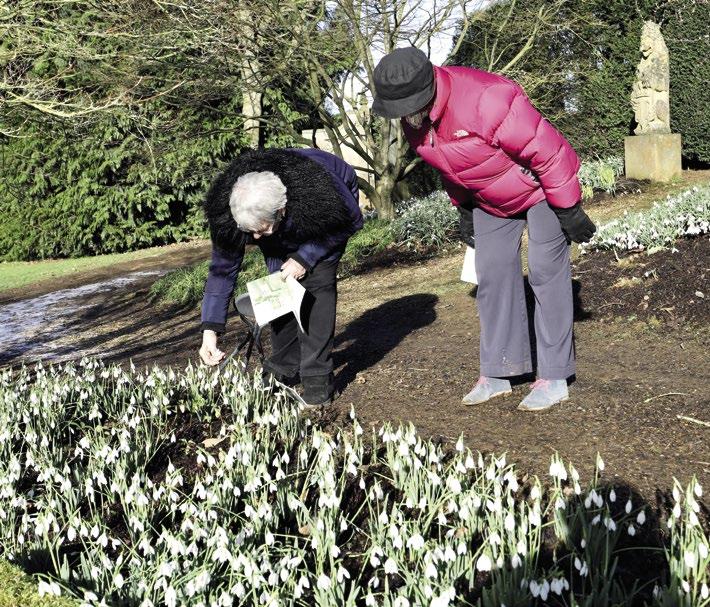
Where to see snowdrops this February
Boughton House does the ‘snowdrop carpet’ to stunning effect under its ancient trees, and the last time I visited the honey scent was delicious. Open 27th February with NGS. www.boughtonhouse.co.uk
Canons Ashby has prettily naturalised snowdrops in the paddock and in the wonderfully restored formal gardens. Open daily from 12th February www.nationaltrust.org.uk/canonsashby
Coton Manor, one of the finest privately owned and managed botanic gardens in the county is open for both their wonderful snowdrops and exquisite hellebores. Open last two weekends in February, and the first weekend of March www.cotonmanor.co.uk
Deene Park also has an impressive collection of varieties set in their manicured and topiaried formal gardens and canalised woodland gardens. 20th and 27th February www.deenepark.com
Lamport Hall can offer you snowdrops and art! They are hosting the Northamptonshire Open Studios Spring Exhibition over the weekend of 19th - 20th February too. Artists will be creating works of art live. www.lamporthall.co.uk
Rockingham Castle has the most wonderful setting, with views for miles over five counties if it’s a clear day, and carpets of snowdrops too. Check their website for availability. www.rockinghamcastle.com
Thenford Arboretum seems to take the record for the largest number of varieties. It’s such a pretty spot, and is home to 675 different varieties of galanthus, under the care of Emma Thick, aka ‘the snowdrop lady’. Open afternoons of 9th, 19th and 22nd February 2022. www.thenfordarboretum.com
Badby Woods, The Nuttery and Evenly Woods are wonderful places to enjoy snowdrops in the most natural settings. Managed by the Woodland Trust, you will also see other winter flowers such as aconites and primroses as the season develops. www.woodlandtrust.org.uk
And the National Garden scheme is worth a look for more places in Northamptonshire that may be opening especially for snowdrops on 27th February 2022. www.ngs.org.uk










